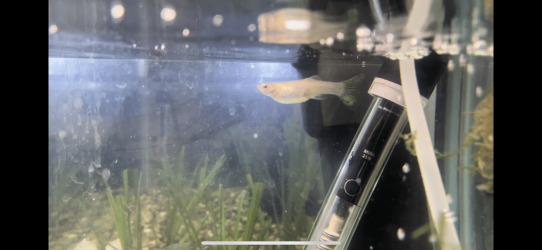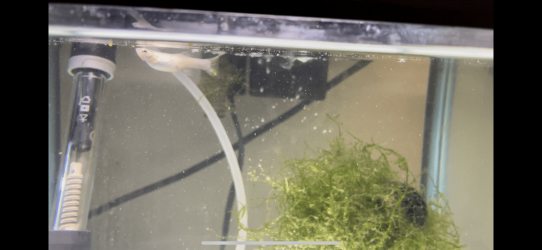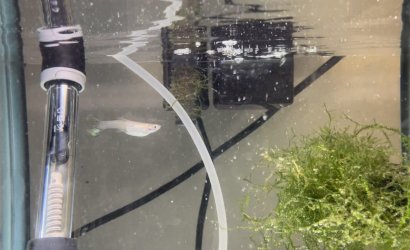wayfareranima
New Member
What is the water volume of the tank? 28L not enough, I’m aware, and shopping for a second hand 100-200L tank.
How long has the tank been running? Mid Oct /23
Does it have a filter? Yes HOB
Does it have a heater? Yes, 25w
What is the water temperature? 25-27*c typically
What is the entire stocking of this tank? two adult female guppies, (new additions) two juvenile female guppies.
Maintenance
How often do you change the water? Atm daily,
How much of the water do you change? 10-25%
What do you use to treat your water? aqua essentials api, also stresscoat+ api,
Do you vacuum the substrate or just the water? It has no substrate, I am clearing out all the fish waste I can see.
*Parameters - Very Important
Did you cycle your tank before adding fish? Yes. Since October/23
What do you use to test the water? Fluval masterkit at first, now API freshwater masterkit
What are your parameters? We need to know the exact numbers, not just “fine” or “safe”.
Ammonia: API = 0 Fluval = .1
Nitrite: API = 0 Fluval = 0
Nitrate: API = 0 Fluval = 0
pH: API = 6.8 Fluval = 5.5
Feeding
How often do you feed your fish?
How much do you feed your fish?
once a day, with a syringe, so it’s presoaked in their water and measured out, no more than they can eat in 30s, fasted one day once a week.
What brand of food do you feed your fish? I changed the diet from sera veggie flakes to aqua one tropical flakes, then added bloodworms and defrosted frozen spinach. Now they’re on Dymax tropical essentials. Been trying to offer a varied and nutritious diet, to tempt the sick fish.
Do you feed frozen? Yes, bloodworms and spinach, but defrosted first.
Do you feed freeze-dried foods? Yes, listed above.
Illness & Symptoms
How long have you had this fish? About three weeks coming up to a month now.
How long ago did you first notice these symptoms? Maybe a fortnight?
In a few words, can you explain the symptoms? I’m most worried about the larger adult female. She has had inflamed gills and laboured breathing, and is less interested in food, and has lost weight.
had some inflammation at the base of her pectoral fins, and was chasing food attempting to eat it and then spitting it back out. The only thing I’ve seen her keep down is fine spinach. She now has what looks like erosion behind her flared, red gills.
Have you started any treatment for the illness?
When I first got the new girls they seemed fine for a few days and even dropped some fry, so I first suspected the inflammation was die to ammonia poisoning, so was doing daily water changes of about 10-20% and using a half dose of aqua essentials + stresszyme.
When she showed little improvement I then suspected gill flukes, and I treated them with melafix and pimafix, epsom and sea salt for five days to try to address what I thought was parasitic infection, while I waited for Para-gone and quick start to be shipped to me.
I did this in response to the ammonia and pH results of my newly bought fluval master kit, but am now doubting its reliability since getting an API master test kit. They contradict each and the discrepancy is significant.
Was your fish physically ill or injured upon purchase?
Didn’t appear to be, but I know gill flukes can lay dormant until stress occurs.
How has its behavior and appearance changed, if at all?
So my main concern is the red inflamed gills that have now developed a scalloped or eroded patch of scales behind them, I assume from her laboured breathing. She was sitting at the bottom the day before I began treatment for bacteria but seemed to improve after 5 days of melafix and pimafix and salt and the air stone.
Looked like she had gained some weight back too.
I stopped using those for 48hrs and did a WC so I could dose the tank with paragone.
The next day she’s sitting at the bottom again, so I do a big water change, around 50% and start melafix and pimafix and salts again.
I am changing the water daily, and have now treated for parasites, bacteria and fungal infections, and she is a bit more active today and swimming around and trying to eat but is still spitting out most bites.
I’m trying not to get my hopes up about her recovery.
The two adult females also developed this black patch on the heads, which from all my scouring on the internet I have determined are either developed from stress and/or ammonia burns.
The larger female developed the patch of black on the head first and then not long after, her blue sister did too.
I did all I could to reduce stress and ammonia, (lights out siesta in the middle of the day, only having the air stone on for a short period on low, stresscoat+ aqua essentials and stresszyme/quick start at half doses, melafix and pimafix and salt for five days) and the black mark went away on the blue girl and reduced on the larger yellow girl.
But since yesterday’s big WC the black mark is now back prominently on both girls.
Explain your emergency situation in detail.
(Please give a clear explanation of what is going on, include details from the beginning of the illness leading up to now)
At first I suspected NH3 poisoning, did all I could to reduce the ammonia and test kits say it is very low.
No nitrites or nitrates because I have been doing daily WCs for a week and a half, and there was a huge java moss with driftwood in there, that I removed yesterday in case it was the cause of the ammonia. The tank has been running for months with dechlorinator and cheap fish flakes in it.
When I stopped the bacterial/fungal treatment for 48hrs to begin the parasite treatment she declined overnight and was sitting at the bottom again.
I did a big WC, tested the tap water, (it’s pH is just above 7 according to API but 6 according to Fluval) and began the pima/melafix+NaCl and epsom salt dosing again yesterday, and she seems a little better this morning.
Chasing the new food and trying to eat it, not quite succeeding, but now swimming around with ease, comes to the glass when I stop by to examine her.
Pictured below are the yellow adult female and then one or two pics are of her sister.
The blue girl without the mark on her heads and the yellow girl with a reduced mark, yesterday from above.
Which testing kit is more accurate and reliable?
How long has the tank been running? Mid Oct /23
Does it have a filter? Yes HOB
Does it have a heater? Yes, 25w
What is the water temperature? 25-27*c typically
What is the entire stocking of this tank? two adult female guppies, (new additions) two juvenile female guppies.
Maintenance
How often do you change the water? Atm daily,
How much of the water do you change? 10-25%
What do you use to treat your water? aqua essentials api, also stresscoat+ api,
Do you vacuum the substrate or just the water? It has no substrate, I am clearing out all the fish waste I can see.
*Parameters - Very Important
Did you cycle your tank before adding fish? Yes. Since October/23
What do you use to test the water? Fluval masterkit at first, now API freshwater masterkit
What are your parameters? We need to know the exact numbers, not just “fine” or “safe”.
Ammonia: API = 0 Fluval = .1
Nitrite: API = 0 Fluval = 0
Nitrate: API = 0 Fluval = 0
pH: API = 6.8 Fluval = 5.5
Feeding
How often do you feed your fish?
How much do you feed your fish?
once a day, with a syringe, so it’s presoaked in their water and measured out, no more than they can eat in 30s, fasted one day once a week.
What brand of food do you feed your fish? I changed the diet from sera veggie flakes to aqua one tropical flakes, then added bloodworms and defrosted frozen spinach. Now they’re on Dymax tropical essentials. Been trying to offer a varied and nutritious diet, to tempt the sick fish.
Do you feed frozen? Yes, bloodworms and spinach, but defrosted first.
Do you feed freeze-dried foods? Yes, listed above.
Illness & Symptoms
How long have you had this fish? About three weeks coming up to a month now.
How long ago did you first notice these symptoms? Maybe a fortnight?
In a few words, can you explain the symptoms? I’m most worried about the larger adult female. She has had inflamed gills and laboured breathing, and is less interested in food, and has lost weight.
had some inflammation at the base of her pectoral fins, and was chasing food attempting to eat it and then spitting it back out. The only thing I’ve seen her keep down is fine spinach. She now has what looks like erosion behind her flared, red gills.
Have you started any treatment for the illness?
When I first got the new girls they seemed fine for a few days and even dropped some fry, so I first suspected the inflammation was die to ammonia poisoning, so was doing daily water changes of about 10-20% and using a half dose of aqua essentials + stresszyme.
When she showed little improvement I then suspected gill flukes, and I treated them with melafix and pimafix, epsom and sea salt for five days to try to address what I thought was parasitic infection, while I waited for Para-gone and quick start to be shipped to me.
I did this in response to the ammonia and pH results of my newly bought fluval master kit, but am now doubting its reliability since getting an API master test kit. They contradict each and the discrepancy is significant.
Was your fish physically ill or injured upon purchase?
Didn’t appear to be, but I know gill flukes can lay dormant until stress occurs.
How has its behavior and appearance changed, if at all?
So my main concern is the red inflamed gills that have now developed a scalloped or eroded patch of scales behind them, I assume from her laboured breathing. She was sitting at the bottom the day before I began treatment for bacteria but seemed to improve after 5 days of melafix and pimafix and salt and the air stone.
Looked like she had gained some weight back too.
I stopped using those for 48hrs and did a WC so I could dose the tank with paragone.
The next day she’s sitting at the bottom again, so I do a big water change, around 50% and start melafix and pimafix and salts again.
I am changing the water daily, and have now treated for parasites, bacteria and fungal infections, and she is a bit more active today and swimming around and trying to eat but is still spitting out most bites.
I’m trying not to get my hopes up about her recovery.
The two adult females also developed this black patch on the heads, which from all my scouring on the internet I have determined are either developed from stress and/or ammonia burns.
The larger female developed the patch of black on the head first and then not long after, her blue sister did too.
I did all I could to reduce stress and ammonia, (lights out siesta in the middle of the day, only having the air stone on for a short period on low, stresscoat+ aqua essentials and stresszyme/quick start at half doses, melafix and pimafix and salt for five days) and the black mark went away on the blue girl and reduced on the larger yellow girl.
But since yesterday’s big WC the black mark is now back prominently on both girls.
Explain your emergency situation in detail.
(Please give a clear explanation of what is going on, include details from the beginning of the illness leading up to now)
At first I suspected NH3 poisoning, did all I could to reduce the ammonia and test kits say it is very low.
No nitrites or nitrates because I have been doing daily WCs for a week and a half, and there was a huge java moss with driftwood in there, that I removed yesterday in case it was the cause of the ammonia. The tank has been running for months with dechlorinator and cheap fish flakes in it.
When I stopped the bacterial/fungal treatment for 48hrs to begin the parasite treatment she declined overnight and was sitting at the bottom again.
I did a big WC, tested the tap water, (it’s pH is just above 7 according to API but 6 according to Fluval) and began the pima/melafix+NaCl and epsom salt dosing again yesterday, and she seems a little better this morning.
Chasing the new food and trying to eat it, not quite succeeding, but now swimming around with ease, comes to the glass when I stop by to examine her.
Pictured below are the yellow adult female and then one or two pics are of her sister.
The blue girl without the mark on her heads and the yellow girl with a reduced mark, yesterday from above.
Which testing kit is more accurate and reliable?
Attachments
-
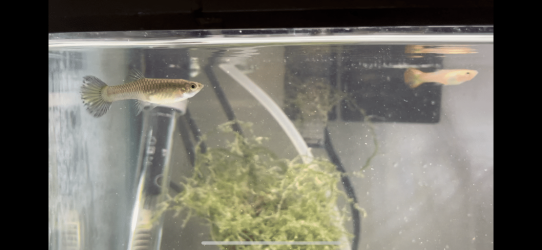 IMG_6852.png414.4 KB · Views: 32
IMG_6852.png414.4 KB · Views: 32 -
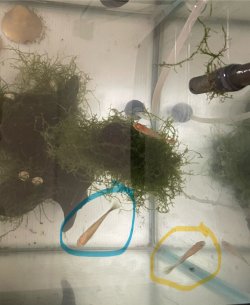 IMG_6824.jpeg243.2 KB · Views: 18
IMG_6824.jpeg243.2 KB · Views: 18 -
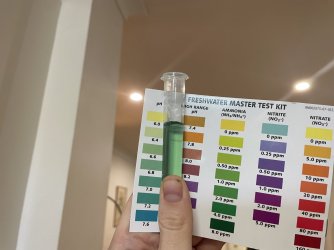 IMG_6833.jpeg165.5 KB · Views: 18
IMG_6833.jpeg165.5 KB · Views: 18 -
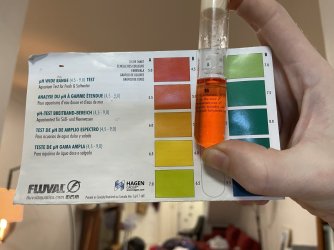 IMG_6835.jpeg221.1 KB · Views: 16
IMG_6835.jpeg221.1 KB · Views: 16 -
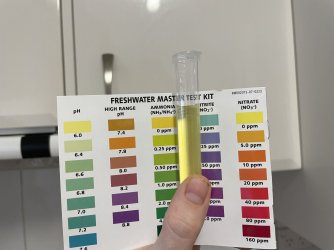 IMG_6841.jpeg177.7 KB · Views: 15
IMG_6841.jpeg177.7 KB · Views: 15 -
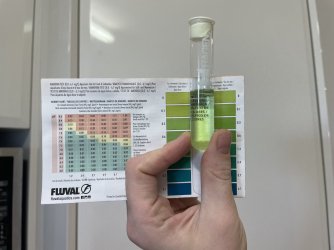 IMG_6842.jpeg192.6 KB · Views: 16
IMG_6842.jpeg192.6 KB · Views: 16 -
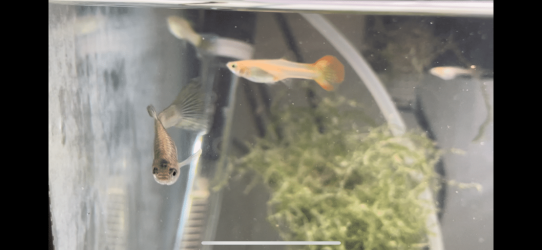 IMG_6876.png445.5 KB · Views: 18
IMG_6876.png445.5 KB · Views: 18 -
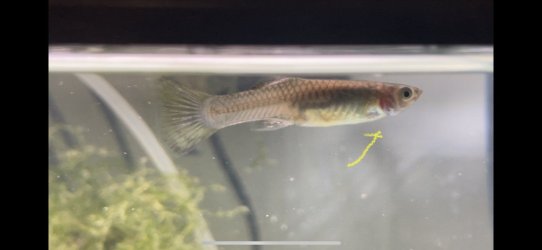 IMG_6869.jpeg68 KB · Views: 17
IMG_6869.jpeg68 KB · Views: 17 -
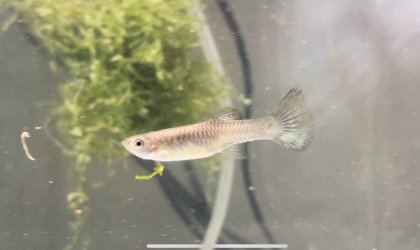 IMG_6854.jpeg104.3 KB · Views: 28
IMG_6854.jpeg104.3 KB · Views: 28



